
Winter 2017 issue of Florida Golf Magazine features "The Florida Golf Architecture of Arthur Hills" Click here to read it.

Written by Golf Course Designer, Pete Dye for Florida Golf Magazine
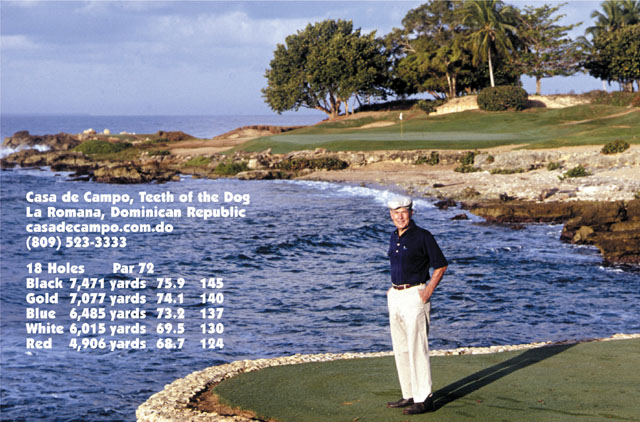 Golf course designer, Pete Dye stands on the beautiful elevated tee of the 229 yard par three 7th Hole at Teeth of the Dog, at Casa De Campo in Dominican Republic.
Golf course designer, Pete Dye stands on the beautiful elevated tee of the 229 yard par three 7th Hole at Teeth of the Dog, at Casa De Campo in Dominican Republic.
|
Teeth of the Dog at Casa de Campo Course Designer: Pete Dye, 1969 18 Holes, Par 72 |
||
|
Tees: Black Gold Blue Whit Red |
Yards: 7,471 7,077 6,485 5,015 4,906 |
Rating / Slope 75.9 / 145 74.1 / 140 73.2 / 137 69.5 / 130 68.7 / 124 |

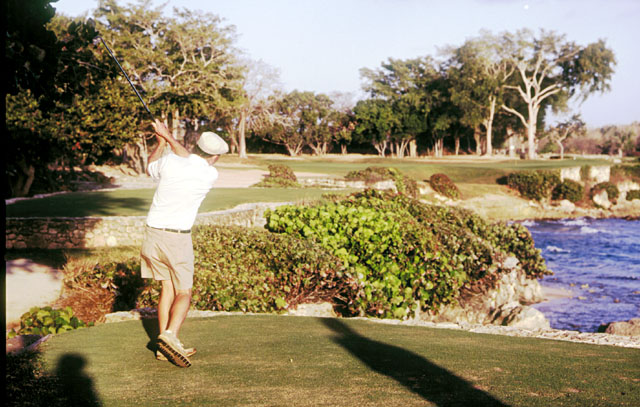 With a swing as smooth as silk, 89 year old golf course designer Pete Dye hits to the huge 7,000 square foot green of the 204 yard, par three 16th hole at Teeth of the Dog.
With a swing as smooth as silk, 89 year old golf course designer Pete Dye hits to the huge 7,000 square foot green of the 204 yard, par three 16th hole at Teeth of the Dog.
 In 1969 I was hired by a man named Alvaro Carta, who ran the South Puerto Rico Sugar company to build a golf course on the southeastern coastline of the Dominican Republic. With the financial backing of the huge Gulf and Western empire, Mr. Carta had formed a new division known as Gulf and Western Americas. More than 300,000 tons of raw sugar was produced annually at their mill in the sleepy little town of La Romana, making it the largest single producer in the world and the luxurious golf resort that is now Casa de Campo evolved because of their vast resources.
In 1969 I was hired by a man named Alvaro Carta, who ran the South Puerto Rico Sugar company to build a golf course on the southeastern coastline of the Dominican Republic. With the financial backing of the huge Gulf and Western empire, Mr. Carta had formed a new division known as Gulf and Western Americas. More than 300,000 tons of raw sugar was produced annually at their mill in the sleepy little town of La Romana, making it the largest single producer in the world and the luxurious golf resort that is now Casa de Campo evolved because of their vast resources.
Teeth of the Dog opened 18 months later, and little did I know at the time, we would not only succeed in building a world-class golf course, but also improve the economic conditions for the mostly impoverished citizenry.

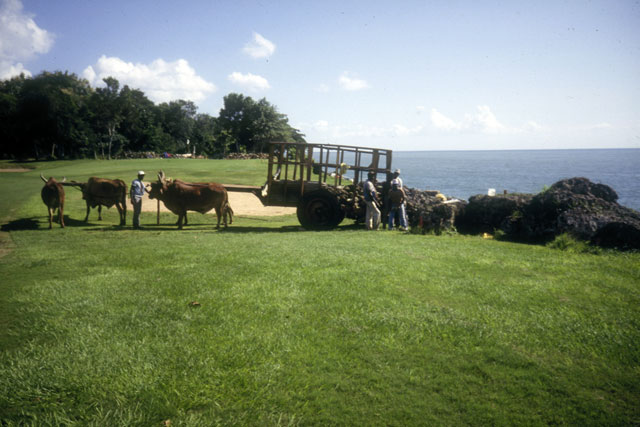
The idyllic ambiance at Teeth of the Dog gives no hint of its arduous origins. Since importing the heavy equipment normally used in golf course construction was cost prohibited, I had to make do with ill-suited machinery whose true purpose was sugarcane cultivation, and substituted man and oxen power instead. Armed only with sledgehammers, pickaxes and chisels, 300 Dominican laborers literally pulverized the coral and limestone-strewn property one harsh blow at a time.
Making matters even more difficult, potential grass-growing top soil wasn’t readily available either. So my right-hand-man, project manager, Bruce Mashburn had the crew dig by hand some dirt that was discovered a mile from the site. It was put into sugarcane carts pulled by oxen and transported to the course property.
As incredible as it may seem, and remember this was in 1970-71, those oxen-drawn carts brought the soil one cubic yard at a time. In my mind, I can still see the long line of cane carts stretched across the countryside as load after load after load was transported down by the tireless workers.

 Born in Pine Bluff, North Carolina, Bruce Mashburn worked first with Donald Ross and then George Cobb after Mr. Ross’s death
Born in Pine Bluff, North Carolina, Bruce Mashburn worked first with Donald Ross and then George Cobb after Mr. Ross’s death
A by-product of sugarcane called cachaza was mixed with sand and the imported dirt to form the topsoil for the golf course. Bruce and I knew this mixture would work since Bruce had pounded green wood survey stakes into the ground and ten days later they sprouted. Despite that success, we still had soil samples analyzed in the United States to make certain our formula would work.
My good friend Bruce Mashburn was an interesting fellow. Born in Pine Bluff, North Carolina, Bruce worked first with Donald Ross and then George Cobb after Mr. Ross’s death. Not only had Bruce been a good player in his early days, but working with Mr. Ross had provided him with a perspective on golf course design very similar to mine. I truly believe Bruce was the only man alive who could have built the golf course in the Dominican the way I wanted it. He read my thoughts, and his ability to work with the laborers was incredible.
Bruce had built golf courses atop high mountains and in deep swampland and his ability to lead the willing but inexperienced Dominican workers was the key to our success. They took to him right away, and he gained the respect of all those who worked for him. Unfortunately for us all, Bruce passed away in September 1971, only months before the course was completed. I know my wife Alice and I will certainly never forget him.

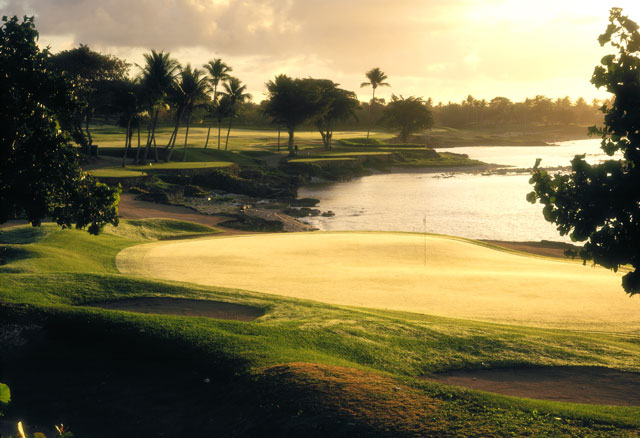
It was early August 1971, when we planted the fairways with 419 Bermuda, the roughs with Bahia grass and guinea grass, and the tees and greens with Tifdwarf. This provided the contrast of green colors I had experimented with at Harbour Town on Hilton Head, SC. On many holes the fairways were painstakingly planted sprig by sprig, blade by blade, by workers using nothing but a little pointed stick.
In the late fall of 1971, the course, which featured seven holes on the sea, was ready for play.
Alvaro Carta’s name for the course was Cajuiles, which refers to the beautiful cashew trees that grow in the mountains. I suggested changing the name when I heard the natives refer to the sharp coral rock as diente del perro (“teeth of the dog” in Spanish), after the canine-teeth appearance of the jagged coral rocks buttressing its seaside tees.

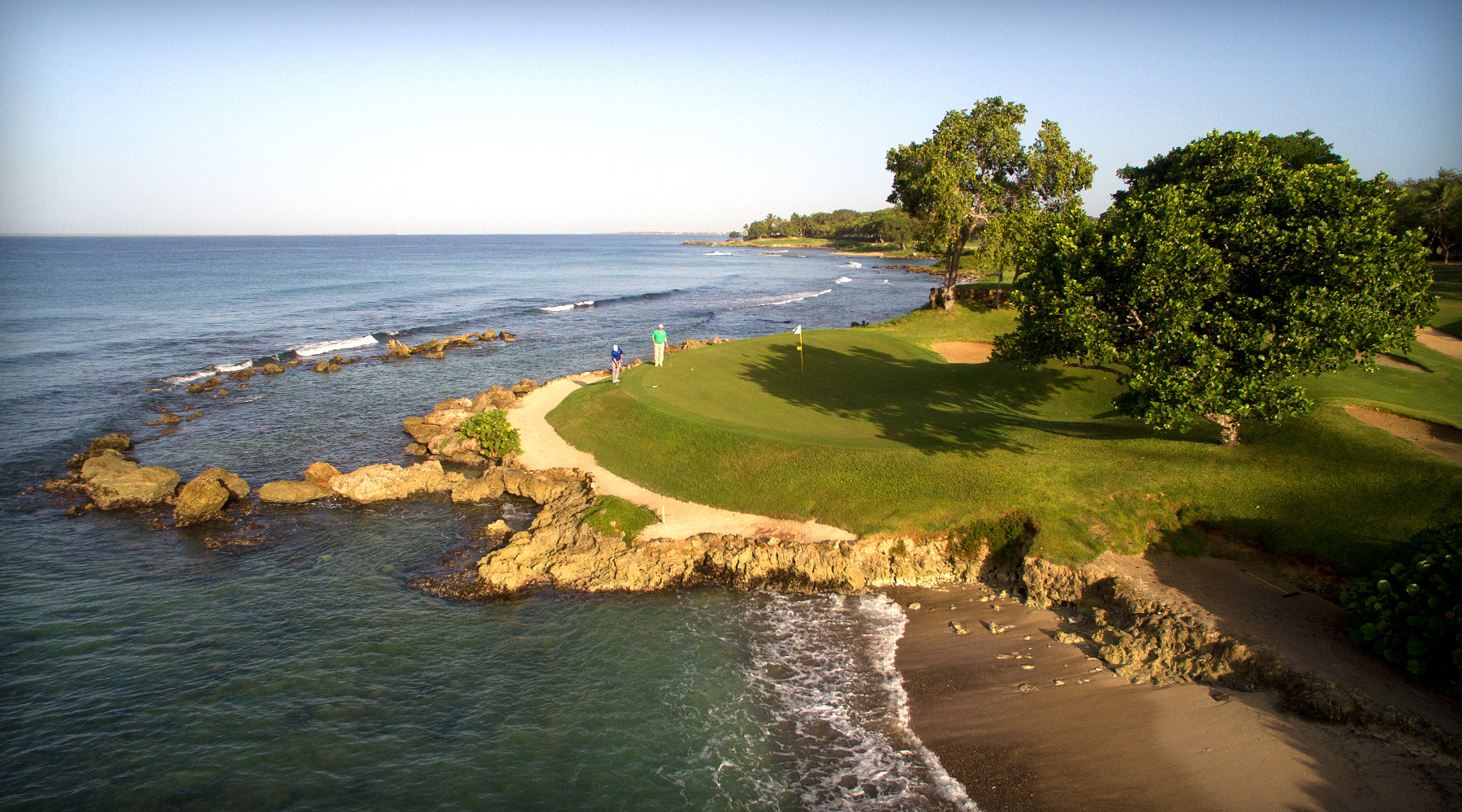
From the day it opened, Teeth of the Dog was a hit and its spectacular beauty caused amateur and professional golfers alike to compare it favorably with another great seaside course, Pebble Beach.
But as spectacular as it may be, Pebble Beach doesn’t have as many seaside holes as Teeth of the Dog. And, as one golfer remarked, “Pebble Beach may have several holes along the sea, but only Teeth of the Dog has seven holes in the sea.”

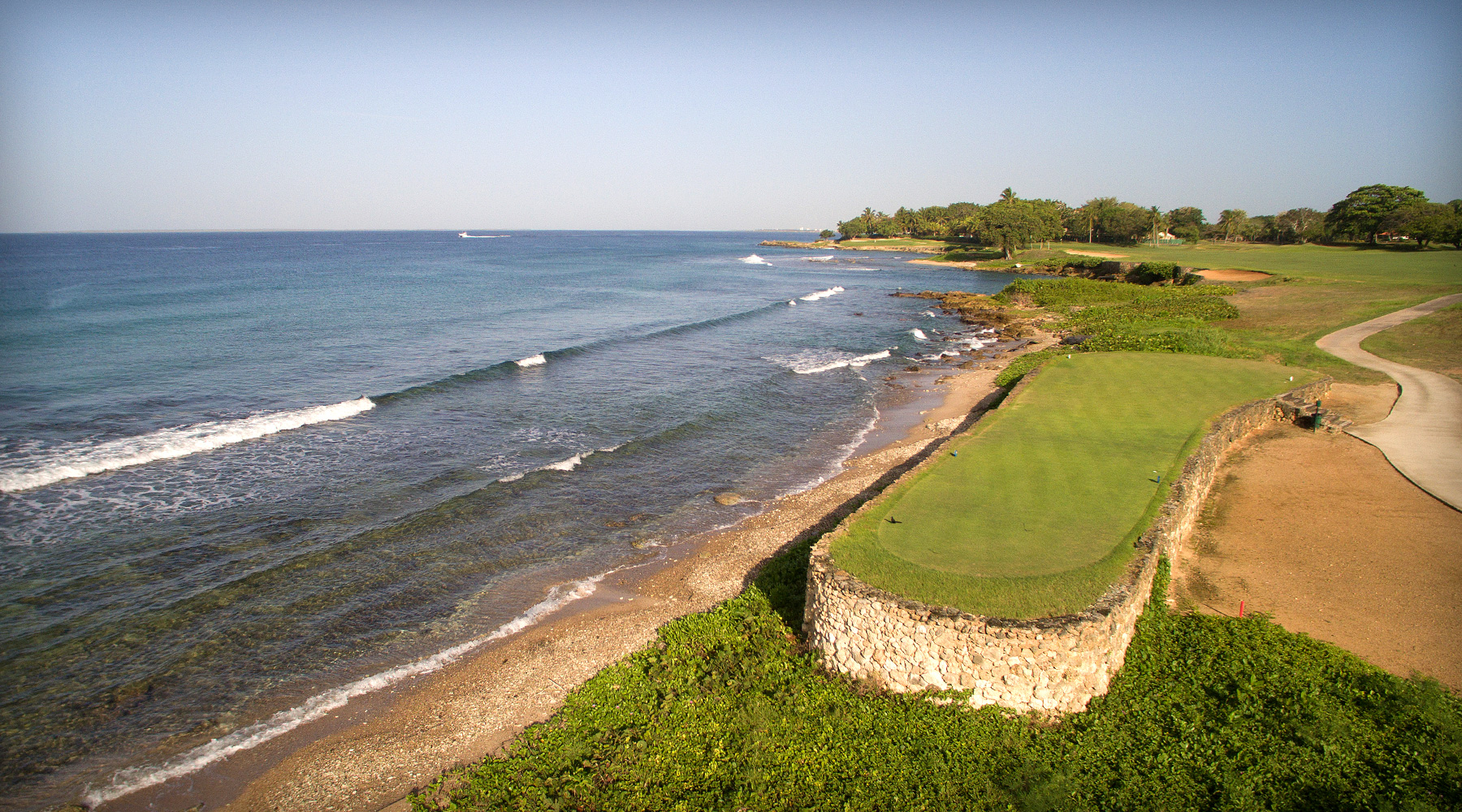
When you’re walking down the fairway of any one of the seven seaside holes or standing on one of the tees or greens right beside the ocean, they’ve got a feel to them that is hard to believe. In the winter months the wind comes out of the northeast so the waves coming into the south edge, off the Caribbean are soft. In the summer months the waves can get a little more exciting, and louder. But even then when you hear them break right at the edge of the landing area and at the green, it’s a gentle sound and doesn’t interrupt play or the ambiance that is Teeth of the Dog. - Pete Dye, 2013

Pete Dye’s Design Notes: - Teeth of the Dog at Casa De CampoHole #1, Par 4, Hndcp 11, Black 412, Gold 393, Blue 366, White 327, Red 277The opening hole at Teeth of the Dog, which runs southeast, is a short par four with a comfortably wide landing area that is all of 200 feet wide. The higher handicap player can not lose a ball on this hole because the fairway is so wide, but also has another 100 feet of rough on each side that is always kept cut very short. The fairways bunkers are also modestly sloped so people can easily play out of them. The green opens up left to right, and the bunkers on the right-hand side of the green and the one on the left are also modest bunkers so the higher handicap players can easily get out of them. The green’s contour is subtle with a one foot of fall from the back to front. It’s an easy green to putt. Hole #2, Par 4, Hndcp 7, Black 390, Gold 384, Blue 358, White 340, Red 255This is a par four measuring about 390 yards from the back tees, it’s a slight dogleg left. The 2nd fairway is plenty wide, but has a rocky dry creek bed that runs all along the left-hand side. Whenever there is a big rain that is where the water drains down, eventually ending up in the Caribbean. The landing area to the right of the rocks is about 150 to 180 feet wide and has more shortly cut rough on both sides so this fairway also has plenty of room to play golf. Also, the far right side of the 2nd hole is further defined by native trees that line the fairway. There is a long narrow bunker on the right side of the green and a small bunker on the left side but the green itself is wide open in front. The wind comes from the left to right making this hole a little more severe than the first hole but the contours on the green are pretty tame and most people can play it. I like the way this hole looks from the tee because you can see all the rock down the left side of the fairway. Hole #3, Par 5, Hndcp 5, Black 551, Gold 498, Blue 457, White 345, Red 353This hole is rated as the 5th hardest hole and is a pretty strong par five playing 551 from the back tees. You can see the ocean from the 3rd hole and the view tee is beautiful. A bunker on the left side of the fairway steers players to right off the tee. The green is open in the front, but even the good players usually still have a wedge to the green on their third shot. There are bunkers left and right of the large green and it slopes about a foot from back to front. The green is also elevated about eight feet above the second landing area so the wedge to the green is a fairly delicate pitch shot. Hole #4, Par 4, Hndcp 17, Black 489, Gold 443, Blue 364, White 328, Red 292The back tees for the long par four measure 489 yards but I’d say most of the higher handicap resort golfers probably play the tees at 364 or 328 yards, and the tee is elevated so you get a really nice view of the ocean. Now, the landing area of the 4th fairway is not as wide as the first three holes. It’s about 140 feet wide and there are a couple of long bunkers on the right hand side of the fairway. So, anyone that stays left should have an open shot to the green and a chance to birdie the hole. The green receives balls nicely because it is sloped from back to front with a foot of fall. But be warned, the green also runs a little left-to-right and the diabolical bunker right of the green is eight feet deep, ‘but I digress’. Hole #5, Par 3, Hndcp 15, Black 176, Gold 157, Blue 137, White 122, Red 70The tees of the 5th hole run along the ocean and are elevated eight feet above sea-level and are made up of native rock walls. It has a pretty good size green and seaside bunker left of it that are only four feet above sea-level. The waves come right up next to the left side of the seaside bunker and green, but never splash up on the Paspalum green. The hole runs west so the prevailing wind often blows right to left. There is a small bunker right of the green that is shallow and easy to get out of. There is also a mound right of the green so any shot right of the green will kick left toward the green. The 5th green is also contoured very modestly and has “birdie opportunity” written all over it. Hole #6, Par 4, Hndcp 1, Black 501, Gold 474, Blue 400, White 377, Red 345Rated as the hardest hole on the course, this long par four runs west along the ocean and measures 501 yards from the back tees. Bunkers along the left side of the fairway and guarding the left front of the green make it necessary to stay on the right side of this dogleg left. The green opens on the right and runs right-to-left and all the contouring on the right side of the fairway also kicks in toward the green. The 6,000 square foot green has a foot of slope from back to front making it receptive, but it also slopes away from the ocean an inch per every 10 feet. Hole #7, Par 3, Hndcp 13, Black 229, Gold 224, Blue 188, White 168, Red 91Seven is a par three that measures 229 yards, mostly over water, from the back tee and 91 yards over land from the forward tee. The green is 7,000 square feet and has a foot of fall from back to front. It also has a modest amount of undulating contour, but since it is so big it still has plenty of places to put the pin. The bunkers around the green are shallow and easy to get out of and they really make the green look good. If you don’t land in one of the bunkers on the right, the bank on the right side will kick your ball into the green. The bunker in front and left of the green also really looks good coming right out of the ocean like it does. I don’t know why the sand in it doesn’t wash away, but it doesn’t. Hole #8, Par 4, Hndcp 3, Black 414, Gold 414, Blue 397, White 329, Red 285This is the fourth hole in a row that runs westward along the ocean and this beautiful midsize par 4 is rated as the 3rd hardest hole from the back tee. It measures 414 yards from the back tee, but most of the higher handicap resort patrons don’t play it from back there. There are six tees to choose from with the most forward tee measuring a more manageable distance of 285 yards. It is a slight dogleg left with a large green on the ocean. There is a big bunker on the front left guarding the green and the green opens toward a bank on the right, so anything that goes right kicks left toward the green. There is also a collection area behind the green on the right that drops down about six feet so anything that goes back there lands in a grass swale. But its short grass and easy to hit out of from there. I love this hole, it’s got the Caribbean on the left and the next thing out of bounds is Venezuela. Hole #9, Par 5, Hndcp 3, Black 602, Gold 545, Blue 529, White 516, Red 408Nine is a nice long par 5 that runs northwest back toward the clubhouse. It plays 602 from the back tee, but most of the golfers don’t play from back there. They play mostly from the 529 or 516 yard tees. From the tee of the 9th hole you can see a big long bunker up on the left side of the fairway and the landing area is pretty wide there, so off the tee it feels like you’re playing right to left. During the winter months the prevailing wind blows right to left, helping you to draw your tee shot. Further up the fairway there are some bunkers on the right to avoid and the approach to the green breaks off to the right so you might want to play your second shot a bit left to right. The approach to the green is very much uphill so a good player, playing from the correct tee might be able to get home in two, but from the back tees, they can’t. Hole #10, Par 4, Hndcp 16, Black 405, Gold 396, Blue 387, White 351, Red 300This is a pretty hole with native trees defining both sides of the fairway. It’s a midsize dogleg left with a huge bunker that dominates the entire left side of the hole and thanks to the wind it usually plays a little shorter than it measures. The green is open in front so if you stay right of the big fairway bunker you should par this hole. Hole #11, Par 5, Hndcp 8, Black 604, Gold 575, Blue 555, White 540, Red 458Hole #11 is a long par 5 that runs west and also favors the prevailing wind. Giant bunkers on both sides of the fairway make the drive feel like a right to left shot off the tee. Then another big bunker on the right makes the second shot feel like a left to right into an approach area of the green. The green is elevated a few feet above the natural grade of the ground and the putting surface is sloped from back to front and a little bit left to right but the green is wide open in front. This hole is a lot easier than it looks. Hole #12, Par 4, Hndcp 12, Black 483, Gold 451, Blue 402, White 362, Red 332The 12th is long for a par 4 measuring 483 yards but it plays a little shorter than that because it runs southwest, which is directly downwind. It’s a dogleg left with a large fairway bunker on the left that steers golfers right to left off the tee. Then, bunkers on the right front of the green offset it left to right making it feel like your second shot needs to be cut a little left to right into the green. There again, the green is pretty good size with a foot of fall back to front and the contour of the green is set up to receive a left to right approach shot. Hole #13, Par 3, Hndcp 18, Black 201, Gold 180, Blue 170, White 143, Red 97Just like the 17th at Sawgrass, we call this par 3 an island green, but instead of water, this island green is completely surrounded by sand. The 13th hole is a long par 3 from the back tee, but it is rated as the easiest hole on the course. Most of the golfers, who get on this green in one, do it by playing from one of the shorter tees according to their handicap. This hole is another excellent birdie opportunity. This island green is over 6,000 square feet and slopes a little from back to front. But, the contour all around the edge of the green leads up out of the bunker with a gentle 5-to-1 slope making it possible to often putt out of the firm well-packed sand. They rake this bunker two or three times per day; there must be at least an acre of sand around that green. Hole #14, Par 5, Hndcp 10, Black 497, Gold 497, Blue 487, White 452, Red 363#14 is a short par 5 that plays dead into the prevailing wind. A long bunker down the entire right side of the fairway makes this hole open left to right off the tee. Then, when you get down the fairway a bit it doglegs right around a lake making for a second left-to-right shot toward the green. Bunkers guard the right-hand side of the green which runs left-to-right but the left hand side is open so if stay far enough to the left you can bounce it into the green if you want to. But if you don’t stay far enough left your approach shot to the pin will have to go air-mail over the sand. Interesting enough, the lake on 14 is lined with a type of clay called caliche that we dug out of that very spot. In fact that clay pit which is now a five acre lake is where we got the clay to build all the roads around the resort at Casa de Campo. Hole #15, Par 4, Hndcp 4, Black 374, Gold 374, Blue 334, White 311, Red 257Just a short walk from the 14th green, the elevated tees of the 15th hole are set along the rocky shore next to the ocean. It’s a beautiful hole that runs southeast and you can see the ocean from the tee, fairway and the green. Measuring 374 yards from the back tee, #15 is a short par 4, but it’s rated as the 4th hardest hole on the course. A long bunker guarding the ocean along the right makes it necessary to keep your tee shot left which is difficult with the prevailing wind blowing left to the right. The 15th green which is guarded on the right front by a bunker is open on the left and is offset left to right requiring a left to right approach shot to the green. If you manage to keep your tee shot far enough to the left you can roll your ball into the 15th green. Hole #16, Par 3, Hndcp 14, Black 204, Gold 194, Blue 181, White 151, Red 125Right off the back of the 15th green is the ocean and the nearby back-tee of #16. The par three 16th hole measures 204 yards from the back tee and 125 yards from the forward tees, but most of the high handicap players play it from either the 181 or 151 yard tee markers. The 16th green is huge. It’s all of 7,000 square feet and it’s right at the edge of the ocean. The ocean makes a big bend to the right there and the green goes right around and bends with the ocean. So the left side of the green is easy to get to and the back right is a little more severe. And of course, the prevailing wind is coming from left to right on that hole, blowing toward the ocean. To the right, off the edge of the green is a natural rock wall straight down to the ocean. So it is possible to hit your ball off the green into the ocean. It’s not going to roll of by itself though; you would have to hit it off the green there, because the green slopes mostly back to front. The contour does also run a little north-to-south or left-to-right but it’s only falling about an inch and a half every ten feet. Everyone loves the 16th hole. It’s a beautiful hole; you’ll never see another one like it. The man upstairs built that hole; I didn’t have to do anything except build the green. Hole #17, Par 4, Hndcp 2, Black 463, Gold 433, Blue 377, White 360, Red 288#17 is a long par four measuring 463 yards from the back tee and is rated the second hardest hole at Teeth of the Dog. With the Caribbean on the right, it runs southeast so the prevailing wind out of the northeast usually blows left to right off the tee. This hole is a slight dogleg right that follows a natural rock wall along the concaved edge of the sea. There is also multiple fairway bunkers way off to the left side, but nobody ever gets over there. A large bunker guards the right side of the green which is offset right to left, but it’s open in front. You can put the pin just about anyplace on that green. Hole #18, Par 4, Hndcp 6, Black 484, Gold 445, Blue 396, White 370, Red 310On Hole #18 you’re going northwest back toward the clubhouse and the green is about 20 feet higher than the landing area so it’s uphill and into the wind. It’s a long par four; measuring 484 yards from the back tee and 310 yards from the forward tee. But most of the higher handicap golfers play it from either the 396 or 370 yard tee markers. Left of the landing area there’s an irrigation pond and part of it also guards the left side of the green. The approach to the green doglegs left around the pond and the green is offset right-to-left but open in front. It’s a good finishing hole with plenty of room off the tee for the resort players and a landing area that’s 200 feet wide. I usually play #18 right-to-left off the members’ tee, then I hit a right-to-left approach shot to the green and hopefully two-putt for a par. |




